
Volleyball can be a lifelong hobby or a means to a college education. It can break down cultural barriers, provide lasting friendships and overcome divides that feel impossible to bridge.
However, perhaps the greatest gift volleyball has to offer is a sense of belonging. For marginalized communities like LGBTQ youth, the opportunity to be a part of a team and play a sport like volleyball can be life changing and, in some cases, even lifesaving.
A national survey of more than 40,000 LGBTQ youth conducted by the Trevor Project in 2020 found that 40% of LGBTQ youth seriously considered attempting suicide, and 68% reported symptoms of generalized anxiety disorder. The survey results highlighted a correlation between LGBTQ discrimination and mental health challenges among youth. However, survey findings also showed that LGBTQ youth who participate in sports reported higher grades and fewer symptoms of depression.
Creating a culture of inclusion in your volleyball program has never been more critical than now. Below are a few tips to create a safe and affirming space for LGBTQ youth.
Create a code of conduct
One of the most effective ways to demonstrate your support for LGBTQ inclusion is to create a code of conduct that strictly prohibits anti-LGBTQ language, attitudes and behaviors. Specify that homophobic, transphobic and heterosexist dialogue or bullying of any kind will not be tolerated on your team, within your club, at your tournament or in your gym. This clear messaging sends a strong signal to LGBTQ youth that they are welcome in this space.
Galen Dodd, technical coordinator for the U.S. Men’s Sitting Team and assistant men’s volleyball coach at Loyola University Chicago, shared his experience of playing in California.
“I never felt that it (being gay) was an issue, but I’ve definitely heard derogatory commentary and there was always that unconscious concern. The homophobia I experienced in volleyball didn’t quite come out as an explicit experience; it came out more as subtle jabs.”
Those subtle jabs of homophobic and transphobic language might just be the tipping point for an aspiring young volleyball player. Protecting LGBTQ youth by adopting a clear code of conduct could reduce athlete burnout and dropout.
Adopt inclusive language
The importance of incorporating affirming language into your website, coaching discourse and daily dialogue can not be underestimated.
Using the correct terminology when speaking about LGBTQ athletes can make players feel supported, but using the wrong terms can make players feel alienated, misunderstood or even attacked.
When trying to incorporate inclusive language, the overarching rule is: Do not make assumptions about anyone’s sexual orientation or gender status. If you are uncertain on how to speak, always ask for preferred pronouns and mirror the language of the person you’re speaking with.
Show your support
One of the simplest ways to demonstrate allyship is to display a rainbow flag or sticker in your office, gym, social media profile or anywhere that it can easily be recognized. The pride rainbow communicates to LGBTQ folks that the space is safe and they are welcome. Many LGBTQ nonprofits give out stickers or downloadable flag printouts for free so that businesses and educators can create a safer environment by demonstrating allyship.
Lean into brave conversations
The best way to overcome cultural divides and heal wounds is to listen to one another’s personal stories. So much of fear and hatred comes from a misunderstanding of what it’s like to walk in another person’s shoes.
When Giovana Melo took over as the director of women’s volleyball for CSU Bakersfield, she designated one of the team’s season matches as “pride night” and bought her team rainbow shirts. However, a few of her players initially resisted.
“That’s when I realized I needed to have a conversation with my team about this, so we sat down and talked about the reasoning behind the event. It was not easy for me to have that talk with my team, but it was an educational opportunity that I did not want to miss,” she said. “Some of my players opened up and shared stories about their own family members who had come out. Everyone had a different situation, and the conversation became bigger than just the event.”
At the conclusion of the meeting, the team voted unanimously to wear the rainbow shirts in support of inclusion, and pride night has become an annual tradition on their campus.
USA Volleyball’s Commitment to Inclusion
USA Volleyball supports the inclusion of transgender athletes in USA Volleyball events in the gender in which they self-identify, yet also prioritizes a fair and competitive landscape. For more information, read our Gender Competition Guidelines. The organization also continues to focus on diversity, equity and inclusion for its staff, clubs and membership. Visit our DEI page for more information on our initiatives, and for resources for LGBTQ youth.
